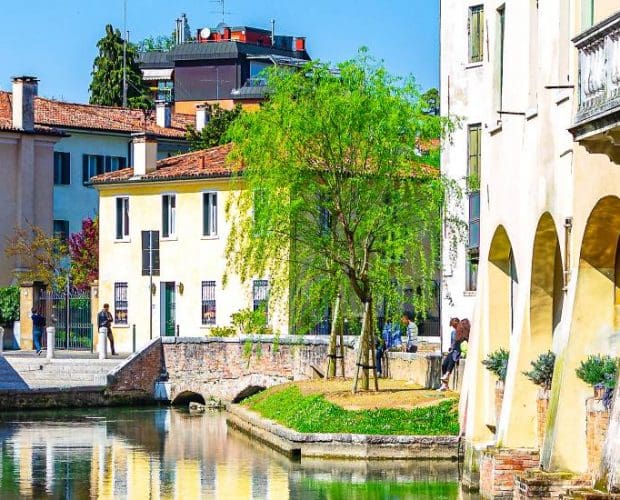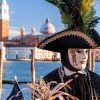Explore Treviso, Italy: serene canals, historic charm, fine cuisine, near Venice & Prosecco country, perfect for a culinary retreat.
Read more
EXPLORE ALL OUR VENETO WINE REGION GUIDES
Last updated: December 9, 2023
Prosecco has long been marketed as a monolithic category: pear drop-scented bubbly that is both readily available and a darn sight cheaper than Champagne. This perception, willingly reinforced by the supermarkets and major discounters, has made Prosecco a global sparkling phenomenon without parallel; international sales rose to 638 million bottles in recent years, worth over $3 billion. Many consumers enjoy the drink, yet most would never countenance taking it seriously or paying more than $15 for a bottle.
However, Italy’s default fizz does have more to offer than instant gratification. For one thing, there are a number of elevated subzones and superior classifications; for another, Prosecco Rosé adds a dash of Pinot Noir to create a more complex and phenolic expression of this versatile bubbly. There is even a selection of traditional-method cuvées made under the Prosecco banner today. A cut-price, fun alternative to Champagne? That’s only a half-truth.
The name Prosecco (then spelled Prosecho) was not mentioned until the 16th century, when it was recorded in writing by an English author, Fynes Moryson. However, still, wines have been made in the Veneto region since the pre-Roman period; the Phoenicians and Greeks introduced several exotic grape varieties to the Italian mainland, used to make potent concoctions that were slowly maderized over flames, sweetened, and mixed with herbs and seawater. Sound revolting? Perhaps, but for the ancients, it was the nectar of the gods. The Romans continued this tradition after they conquered Veneto in the 3rd century BC, spreading viticulture to all corners of the Italian Peninsula.
However, the Western Roman Empire faded into dust in AD 476, paving the way for centuries of conflict and upheaval. In the 6th century, barbarian hordes attacked settlements across northeastern Italy, which led to a massive diaspora as refugees fled the besieged cities. One group of people found safety on the mudbanks of a lagoon, settling on the island of Torcello. Over time, they spread out to the surrounding islands before colonizing Rialto, which has become the heart of Venice. In 726, the people of this rapidly growing commercial center elected Orso Ipato as their first duke (Doge). The priorities of Ipato and his successors would be to advance Venice’s economic interests and remain politically neutral.
Indeed, the Venetians were very instrumental in developing the vineyards of Prosecco, importing Greek varieties, and trading with any willing parties, including the Muslims of Syria and Spain in the Middle Ages. By the end of the 1500s, Venice was known across Europe for its paintings and magnificent architecture.
Three hundred years later, the first modern spelling of the word Prosecco was documented by the writer Aureliano Acanti in 1754. These still and invariably sweet white wines had certainly made a strong impression on Acanti:” I would like to wet my mouth with that Prosecco with its apple bouquet.” Nevertheless, sparkling versions only appeared in the early 20th century. The catalyst for Prosecco’s transformation into a spumante wine was the discovery of the Marinotti method, named after its pioneer, Federico Martinotti.
In the 1800s, Martinotti realized that you could save a great deal of time – and money – by undertaking the secondary fermentation in tank, as opposed to the traditional method (secondary fermentation in bottle). This technique was honed and improved by Eugène Charmat, and, as a result, it is now widely known as the Charmat method. In the late 20th century, Prosecco began to export its sparkling wines to key markets like the US and UK, building a loyal following among consumers. It has become insanely popular over the past 15 years, eroding Cava’s market share in the process.
Prosecco is made in the hills of northeastern Italy, encompassing vineyards in both Veneto and neighboring Friuli-Venezia Giulia. Historically, the heartland of production was centered in the towns of Conegliano and Valdobbiadene, to the north of Treviso. Yet, before 2009, Prosecco’s geographical boundaries were not officially delimited under Italian law – Prosecco was the name of the variety and could thus be made anywhere. This fact was keenly exploited by wineries in Australia, who made vast fortunes exporting an Antipodean version of Italy’s leading fizz to markets like New Zealand. This led to much consternation in the cellars of Treviso until the authorities decided to act. The solution was to register Prosecco as a protected designation of origin, albeit the boundaries of the DOC are vast indeed. Meanwhile, the name of the variety was changed to one of its regional synonyms, Glera.
As a result, a new quality pyramid was formed to distinguish between ‘everyday’ Prosecco and wines made in the traditional heartland of Conegliano and Valdobbiadene. Prosecco DOC is at the base of the hierarchy: huge swathes of productive vineyards in Veneto and Friuli-Venezia Giulia. Next in line is Prosecco Treviso DOC, restricted to vineyards that flank that handsome city north of Venice. However, the true classical zone is Conegliano Valdobbiadene Prosecco Superior DOCG. Finally, Prosecco’s unofficial ‘Grand Cru’ terroir is the hill of Cartizze. Vines planted on this Unesco World Heritage Site yield the finest Prosecco wines in Italy: light, creamy, and dangerously moreish. Meanwhile, the local soils range from iron-rich clay to calcareous marls and free-draining sandstone.
Traditionally, there has been very little interest in terroir from critics and consumers, the general perception being that Prosecco is a mass-produced industrial product. In many cases, that’s true. Yet there are over 40 individual crus in Conegliano Valdobbiadene, known as Rive, that produce a wide variety of styles; Congeliano tends to yield a more fruit-driven and topical expression of the Glera grape, in contrast to Valdobbiadene’s floral and feather-light base wines.
The critical mass of Prosecco relies on the Charmat method and the Glera grape, occasionally blended with a small percentage of indigenous and/or foreign varieties. This technique was perfected in the 20th century as an inexpensive and efficient way of producing bulk sparkling wine. It essentially involves undertaking the secondary fermentation in large tanks (as opposed to in bottle) prior to filtration and bottling under pressure.
After the berries arrive in the winery, they will be chilled and pressed immediately to release very fresh and pure free-run juice. This must is then often passed through a cooling mechanism, before being subject to an initial filtration to remove any solid matter. It is then fermented in stainless steel at low temperatures using cultured yeast. A sugar/yeast solution is then added to the tank, and the secondary fermentation can begin. The whole process can take less than two months. However, producing Prosecco Rosé will require a more extended period; gently macerated Pinot Noir wines are blended with Glera to create a more structured and weighty style of Prosecco that consumers love. However, too much red wine will create an excess of undesirable bitter phenolics in sparkling wines.
Conventional wisdom suggests that the tank method cannot produce high-quality sparkling wine. However, no hard evidence leads to that conclusion – the problem with substandard DOC Prosecco is the poor quality of base wines rather than any intrinsic deficiencies with Charmat bubbly. A few pioneers in Germany and Italy have used automated paddles to mix up the wine and yeast sediment over several years, creating a wine indistinguishable from traditional-method fizz. Unfortunately, they remain outliers in an industry dedicated to speedy and cost-effective results.
The subject of Prosecco’s image is a delicate issue in the cellars of Valdobbiadene and Conegliano. The creation of a quality pyramid was widely lauded in 2009, yet there has been enormous growth in the generic Prosecco DOC: easy to drink and forget. At its best, supermarket Prosecco has low acidity, a pear drop flavor, and often no qualities that could offend. It is a very pleasant, good-value bubbly for informal occasions, and there’s nothing wrong with that.
Yet producers who fly under the DOCG banner are infinitely more ambitious – they want top Prosecco to be taken as seriously as Franciacorta and Champagne. And, to give due credit, the best sparkling wines of Valdobbiadene, Conegliano, and Cartizze have little in common with entry-level brands; the best Prosecco is brimming with creamy fruit and a wonderfully soft texture. If they have been subject to lees aging in tank – such as Valdo No.10 – the level of complexity and finesse is astonishingly high. Moreover, the vast majority of DOCG Prosecco, including the superlative wines of Nino Franco, cost around $25—a veritable bargain when compared to the leading lights of neighboring Trento DOC.
Of course, you can find private label Champagne that hovers around the $35 mark. Isn’t that the better option? Absolutely not: cheap Champagne (excluding high-quality labels on temporary discount) usually offers the worst value of all sparkling wines. You’ll do far better to look outside of Champagne at this price level or lower. So take our advice: look to the delicious and impressive wines of DOCG Prosecco if you desire high-quality weekend drinking but don’t fancy forking out for Krug. The best examples stand on their own merits, offering an unbeatable price-to-quality ratio in the world of premium sparkling wine.
Bianchetta Trevigiana is a white Italian wine grape primarily grown in the Trentino-Alto Adige/Südtirol and Veneto regions. It's not often used as a single varietal but as a blending grape to enhance acidity in various DOC wines, including Prosecco and vermouth. The name "Trevigiana" is linked to its origin in the province of Treviso.
Chardonnay is a green-skinned grape varietal native to the Burgundy wine region in France and one of the most popular varieties worldwide.
Find out moreUnlocking the Secrets of Prosecco: From Sparkling Delights to Terroir-Driven Excellence | Explore the Diversity of Italy's Iconic Sparkling Wine
Find out moreThe Perera grape, also known as "Pevarise," is known for its high-quality berries with a pear-like taste or shape. It was severely affected by phylloxera and nearly disappeared. Perera was fortunately rediscovered and typically blended with Verdiso and Glera in Prosecco DOC and DOCG wines today.
Explore Pinot Bianco: Shaping Excellence in Franciacorta & Alto Adige Wines. Versatile and Unique Grape, Unveil Its Secrets!"
Find out moreDiscover Pinot Grigio's Transformation: From Ordinary to Exceptional in Italian White Wine. Explore the Revolution!
Find out morePinot noir is a light-bodied red wine varietal closely related to the Vitis vinifera grape and produces the most sought-after red wines in the world.
Find out moreIt’s not all about bubbly in the heartland of fruity sparkling wine. After a day trip to Prosecco’s prettiest villages, head back to Treviso for cicheti (Venetian bar snacks) and sarde in saor (grilled sardines in a sweet-and-sour sauce). Gastronomy is one of the region’s biggest trump cards, and restaurant kitchens only work with the freshest, seasonal ingredients. Many of Italy’s most romantic restaurants are found in Venice, although you’ll pay for the pleasure – especially if you sit outside!
A Guide to the Gastronomy and Cuisine of the Veneto: Read more

Explore Treviso, Italy: serene canals, historic charm, fine cuisine, near Venice & Prosecco country, perfect for a culinary retreat.
Read more
Venice: A romantic labyrinth of canals and history, famed for its art, architecture, and timeless allure in the heart of Italy.
Read more
Verona: A blend of romance, history, and culture, famous for Juliet's balcony, Roman amphitheater, and vibrant wine and opera scene.
Read moreIf you would like us to customize an exclusive luxury tour, contact us and let us know your travel plans. We offer luxury food and wine tours for private groups of a minimum two guests. In addition, all of our private, chauffeured tours are available year-round upon request.

